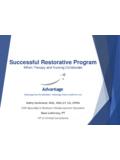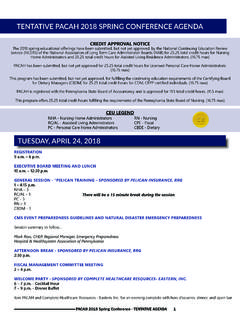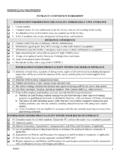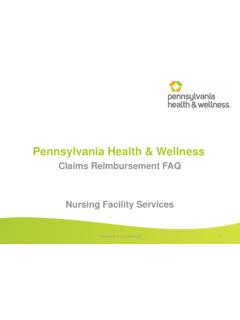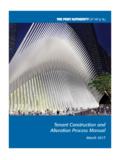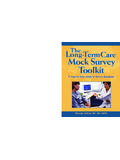Transcription of Steps to Preventing Immediate Jeopardy in the …
1 1 Steps to Preventing Immediate Jeopardy in the areas of Pressure Injury, Falls and Weight Loss:A Therapy ApproachPACAH Spring 20171 Presenter Robin Boyle, , Vice President of operations , Premier Therapy Julia L Bellucci, MS CCC-SLP Director of Clinical Development, Premier Therapy attendee will be able to describe and explain Immediate Jeopardy citation level and some of the risks leading to attendee will be able to define some of the Federal regulations in place for Quality of Care and Therapy Policies and attendee will be able to list out expectations for the Therapy Departments during survey attendee will be able to describe and explain risk areas for Therapy and how to avoid IJ citations in the areas of pressure ulcers.
2 Falls and weight Immediate Jeopardy : a situation in which the facility s noncompliance with one or more requirements of participation has caused, or is likely to cause, serious injury, harm, impairment, or death to a resident. Abuse: the willful infliction of injury, unreasonable confinement, intimidation or punishment with resulting physical harm, pain or mental anguish. Neglect: failure to provide goods and services necessary to avoid physical harm, mental anguish or mental operations manual Chapter 7 Definitions Misappropriation of resident property is defined as the deliberate misplacement, exploitation, or wrongful, temporary or permanent use of a resident's belongings or money without the resident's consent.
3 The definition can be found at 42 CFR Exploitation: taking advantage of a resident for personal gain through use of manipulation, intimidation, or JeopardyRequires Immediate correction as the facility either created the situation or allowed the situation to continue by failing to implement preventative or corrective operations manual Chapter 73 Immediate Jeopardy Is the highest level of citation and carries heavy penalties One IJ can carry many other levels of citations with it; all costing the facility money and puts them at risk to lose Medicare participation7 State operations manual Chapter 7 Prevalence of Immediate Jeopardies In 2011, State of Ohio Department of Health (ODH) data showed a total of 38 IJ citations for the year.
4 In 2016, ODH data showed there was a total of 114 IJ citations Daily fines increased to $6,291 up to $20,628 dollars a day depending on the number of Immediate Jeopardy Bulletin Third Quarter 2016F-tags and Citations Centers for Medicare and Medicaid (CMS) have many different requirements for facilities to meet in order for the SNF to remain citation free during their survey. Each regulation is defined under a F-tag with it s own number. These regulations are clearly spelled out in the State operations manual , and it is frequently referenced throughout this course. It is important for each therapist to understand the requirements from The Centers for Medicare and Medicaid Services (CMS) so that you can meet standards daily in your facilities.
5 If the requirements of each F-tag are not met then a citation to the facility may result during the survey process94 Why Is It Important to Understand and Avoid Immediate Jeopardies? Civil Monetary Penalties can be quite high and devastating in the operation for each facility A ban on participating in the Medicare program Effects 5 star rating and referrals to facility ex. No longer preferred provider Bundled payment programs If facility 5 star rating drops below 3 stars can shut facility out of 3 day waiver for skilled stay with CJR, or the facility may not qualify for 3 day stay rule under bundled payment model10 McKnight's News November 23, 2015 Risk Management Success Depends on These Four of Hazards and Risks Identification of hazards and risks is the process through which the facility becomes aware of potential hazards in the resident environment and the risk of a resident having an avoidable of Hazards and Risks12 All staff ( , professional, administrative, maintenance, etc.)
6 Are to be involved in observing and identifying potential hazards in the environment, while taking into consideration the unique characteristics and abilities of each of Hazards and Risks The facility should make a reasonable effort to identify the hazards and risk factors for each resident with using all resources available such as, quality assurance activities, environmental rounds, MDS/CAAs data, medical history and physical exam, and individual observation. This information is to be documented and communicated across all of Risk Management (cont.)2. Evaluation and AnalysisEvaluation and analysis is the process of examining data to identify specific hazards and risks and to develop targeted interventionsto reduce the potential for and AnalysisInterdisciplinary involvement is a critical component of this process.
7 Analysis may include, for example, considering the severity of hazards, the immediacy of risk, and trends such as time of day, location, and Analysis (cont.)Both the facility-centered and resident-directed approachesinclude:- Evaluating hazard and accident risk data- Analyzing potential causes for each hazard and accident risk- Identifying or developing interventions based on the severity of the hazards and immediacy of risk- Evaluations also look at trends such as time of day, location, of Risk Management (cont.)3. Implementation of Interventions Implementation refers to using specific interventions to try to reduce a resident s risks from hazards in the process includes:- Communicating the interventions to all relevant staff- Assigning responsibility- Providing training as needed- Documenting interventions - Ensuring that the interventions are put into action.
8 17 Implement InterventionsInterventions are based on the results of the evaluation and analysis of information about hazards and risks and are consistent with relevant standards, including evidence-based of interim safety measures may be necessary if interventions cannot immediately be implemented fully. 187 Facility-based interventions may include, but are not limited to:- Educating staff- Repairing the device/equipment- Developing or revising policies and proceduresResident-directed approaches may include:- Implementing specific interventions as part of the plan of care- Supervising staff and residents- Record the implementation of these interventions in your documentation19 Implement InterventionsComponents of Risk Management (cont.)
9 4. Monitoring and Modification Monitoring is the process of evaluating the effectiveness of interventions. Modification is the process of adjusting interventions as needed to make them more effective in addressing hazards and risks. 20 Monitoring and ModificationMonitoring and modification processes include: that interventions are implemented correctly and consistently; the effectiveness of interventions; or replacing interventions as needed and the effectiveness of new interventions218 Monitoring and ModificationAn example of facility-specific modification:-Additional training of staff when equipment has been upgradedAn example of a resident-specific modification:-Revising the plan of care to reflect the resident s current condition and risk factors that may have changed since the previous of Risk ManagementRefer to: Regulation for Quality of CareF-Tag 309.
10 Quality of Care- Frequently CitedThe resident must receive, and the facility must provide, the necessary care and services to attain or maintain his/her highest practicable level of physical, mental, and psychosocial well-being, in accordance with the comprehensive assessment and plan of provider/CMS region 5 meetingState operations manual Chapter 7249 RegulationsFacilities are compliant with Quality of Care (F309) if: Documented evidence risk factors were recognized and assessed for each patient s condition Defined and implementation of interventions are evident that meet each persons needs, goals, and comply with standards of practice Evidence of monitoring and assessing the persons response to the efforts or treatment implemented Modifications and revisions of plan of care are done as appropriateState operations manual Chapter 725 Other Considerations for Quality of CareIf a patient has a Dementia diagnosis, surveyors are looking for other things to be evident in documentation and during care to address Falls, Pressure Injury and Weight Loss risk, such as.
